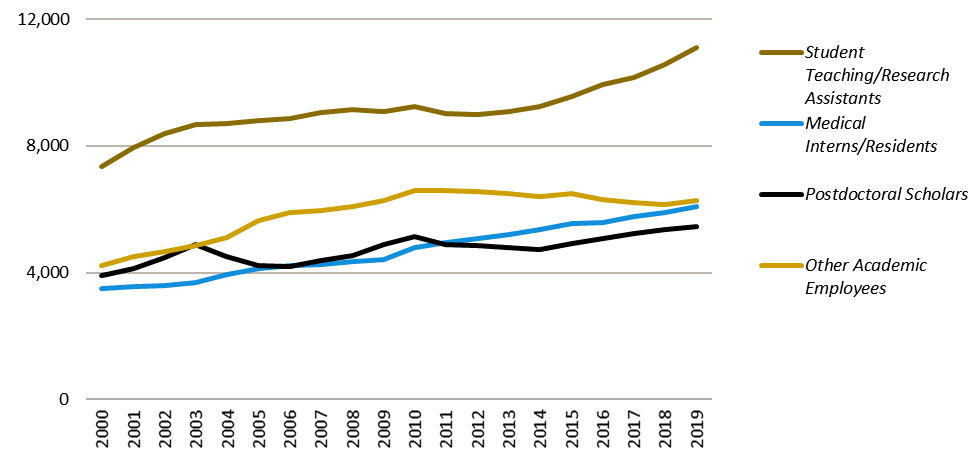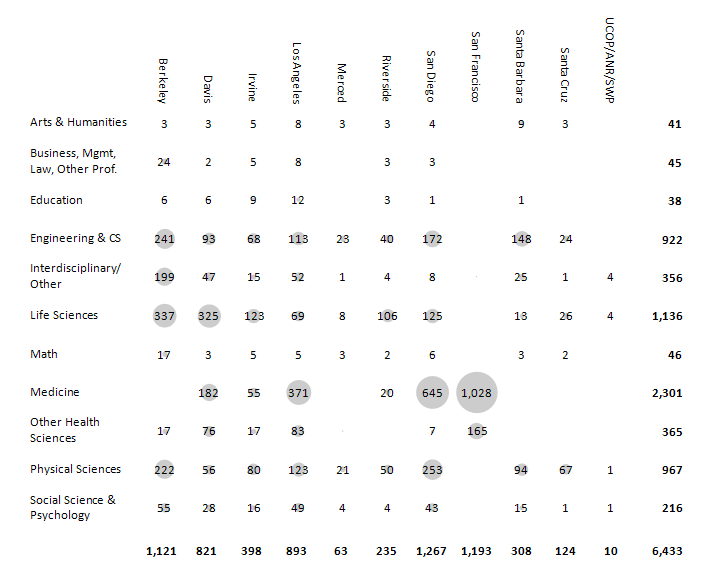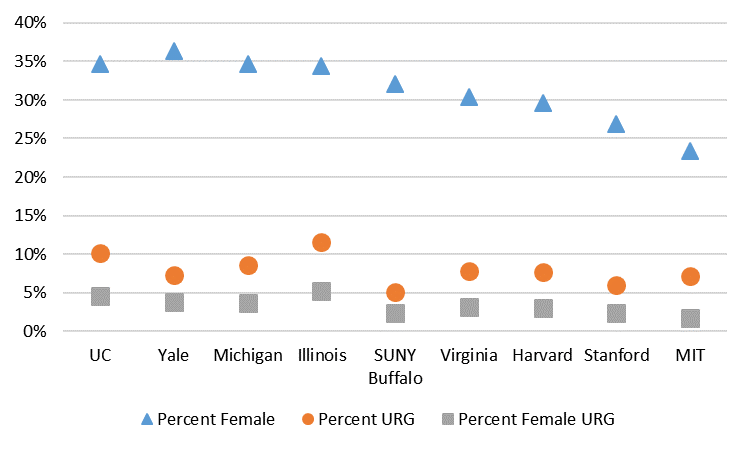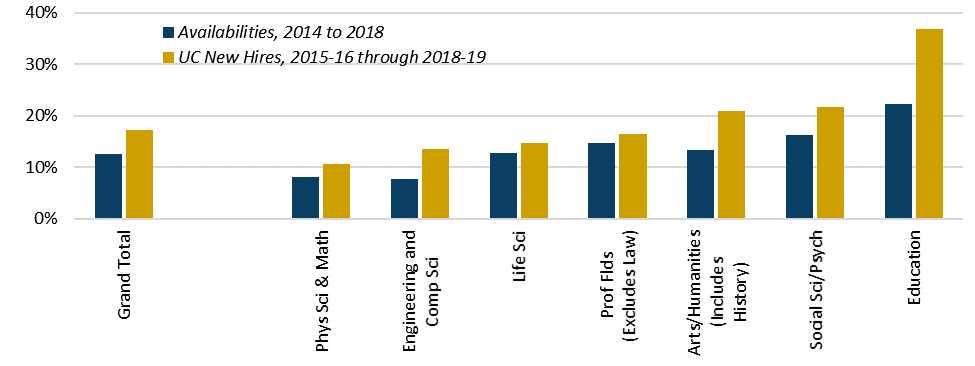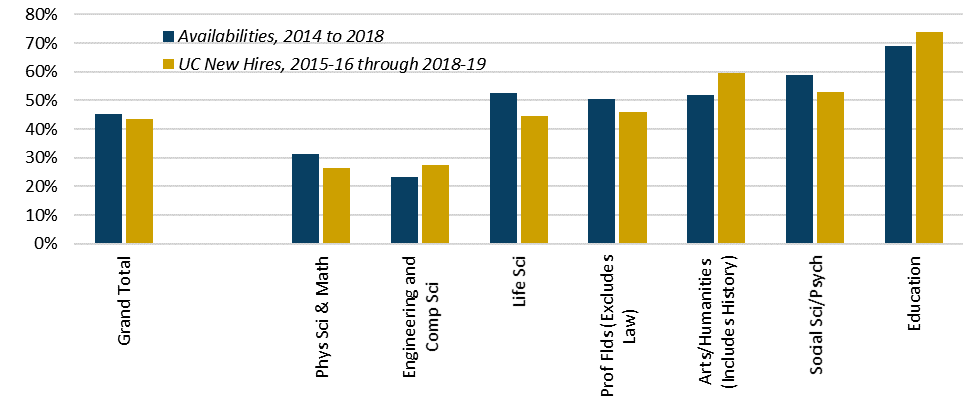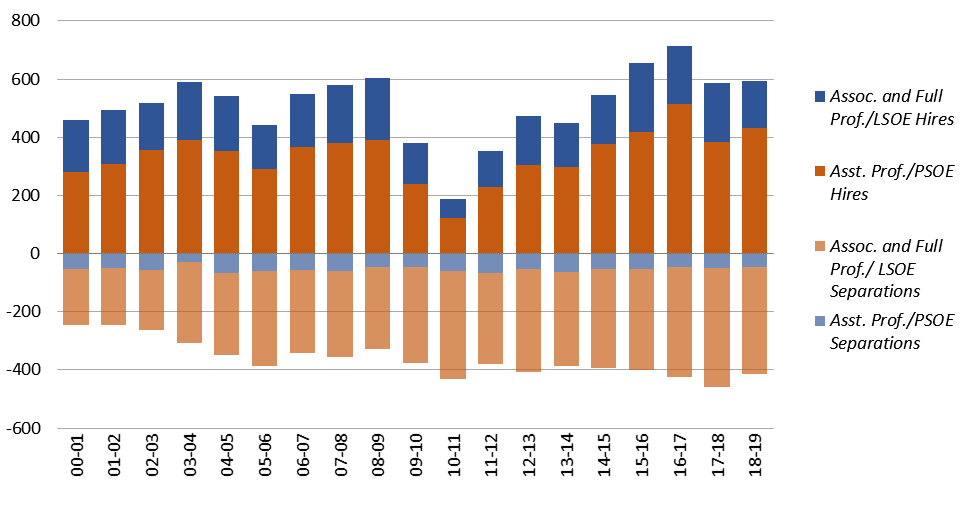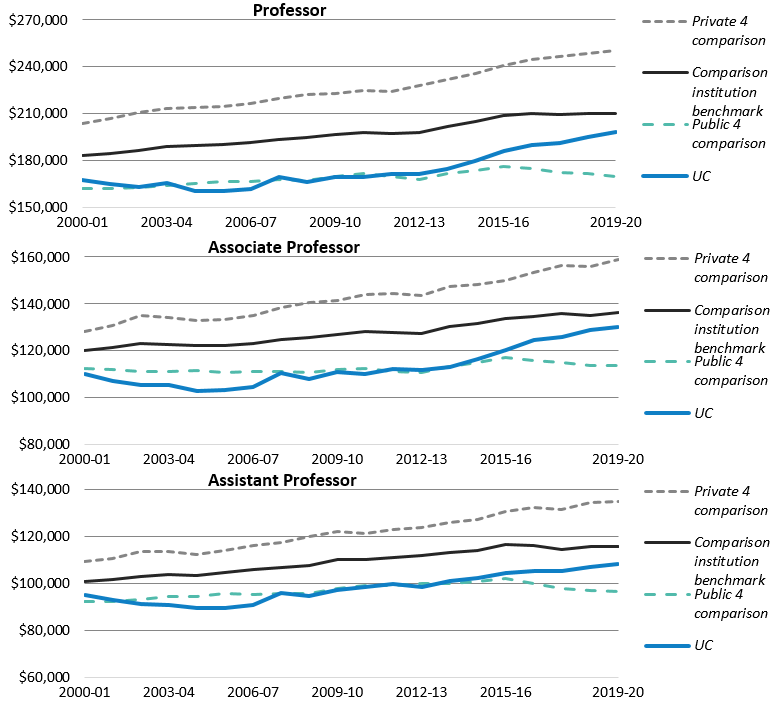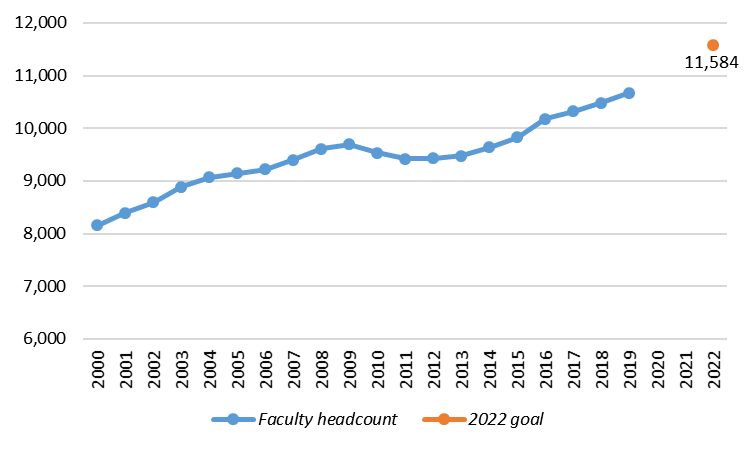Overview
The University of California’s distinguished faculty and other academic appointees serve as a rich source of innovation, discovery, and mentorship. They provide top-quality education to students, develop groundbreaking research, and serve California’s diverse communities.
Describing the academic workforce
Academic FTE and Headcount, October 2019
|
FTE |
Headcount |
| Faculty - Ladder-rank and Equivalent |
10,617.8 |
11,535 |
| Faculty - Clinical/In-Residence/Adjunct |
7,614.1 |
8,528 |
| Faculty - Lecturers |
2,425.4 |
4,029 |
| Other Academic Employees |
6,291.9 |
8,526 |
| Postdoctoral Scholars |
5,454.1 |
6,433 |
| Student Teaching/Research Assistants |
11,108.4 |
27,223 |
| Medical Interns/Residents |
6,086.2 |
6,258 |
| Grand Total |
49,597.9 |
72,532 |
Faculty are the most prominent face of UC’s academic workforce, but there are many other academic roles as well, totaling nearly 50,000 full-time equivalents (FTE) across over more than 72,000 individuals. About 60 percent of faculty are in general campus schools, while the other 40 percent are in the health sciences.
Ladder-rank and equivalent faculty are the core of the faculty in advancing the UC’s tripartite mission of teaching, research and public service. These faculty can advance to tenure or an equivalent status.1 Since the year 2000, their numbers have increased by 39 percent.
The In-Residence, Professor of Clinical (e.g., Medicine), Health Sciences Clinical Professor, and Adjunct Professor series faculty are found at all campus locations, but their numbers are concentrated in the health sciences schools; their duties vary in their focus on research, clinical care, and teaching.
Lecturers are focused on instruction and are hired into part-time and full-time positions. Lecturers can achieve continuing status. Since 2000, the FTE of lecturers has increased by over 74 percent.
Postdoctoral scholars are sponsored by faculty and typically paid through research contracts and grants, so their numbers concentrate in the medical and STEM fields and vary with available grant funding.
Other academic appointees include academic researchers; specialists and advisors in cooperative extension; librarians; faculty administrators such as Deans; university extension teachers; graduate students appointed as Teaching Assistants and Research Assistants; and interns and residents in medicine and other academic health sciences programs.
1 Security of Employment or the tenure-equivalent of associate and full agronomists and astronomers. Diversity
The University of California is committed to diversity and excellence in its faculty and academic workforce. The proportion of women and underrepresented groups (African American, American Indian, Native Hawaiian/Pacific Islander, and Hispanic/Latinx) in the faculty continues to grow at a modest pace. Newer faculty cohorts are noticeably more diverse than past cohorts.
Among tenured and tenure-track faculty, UC compares favorably in terms of the proportions of women faculty and faculty from underrepresented groups relative to the comparison eight peer research institutions.2 And, many academic appointee titles at UC that experience more rapid turnover are more ethnically diverse and gender-balanced than UC’s ladder-rank faculty. Still, UC continues to work to identify opportunities to diversify the faculty and improve recruitment processes and campus climate by tracking recruitment data, by sharing best practices in mentoring and professional development, and by enhancing work-life balance programs.
A variety of programs have been put in place to strengthen faculty diversity:
Advancing Faculty Diversity — The State of California awarded UC $2 million in one-time funds in fiscal years 2016–17, 2017–18, and 2018–19, and $2.5 million in fiscal year 2019–20 to develop an innovative and focused program to increase faculty diversity at UC. The Advancing Faculty Diversity program awards these funds on a competitive basis to campus units implementing new measurable interventions in the faculty recruitment process. To date, sixteen pilot projects have been funded by the state, including projects located in colleges, schools, and departments. In addition, since 2018–19, fifteen awards have been funded by the Office of the President to improve academic climate and increase faculty retention. Some of the successful interventions that correlate with hiring diverse faculty include the use of contributions to diversity statements early in the evaluation process; targeting potential faculty earlier in their careers through support for postdoctoral work; outreach by faculty to actively recruit candidates; revised evaluation practices, including the use of rubrics to guide decision-making; strong leadership and sustained and strategic involvement from unit leaders; and introducing new voices, including students, in the recruitment and evaluation process.Beginning in 2019–20, President Napolitano committed an additional $3 million per year in ongoing funds to support additional projects in faculty recruitment and improved climate and retention to pilot innovative recruitment practices and create academic climates to support UC’s diverse student body and meaningfully engage faculty throughout their UC careers.
President’s Postdoctoral Fellowship Program (PPFP) — Established in 1984, the program recruits top scholars who are committed to underserved and minority communities to pursue faculty careers at UC. Between 2016–17 and 2019–20, 87 fellows were hired as UC ladder-rank faculty at all ten UC campuses. In addition, more than 18 fellows have been successfully recruited for UC faculty positions that will begin in 2020–21, with others still under consideration. Through Presidential support, UC has increased the number of incentives available to departments that hire fellows and expanded eligibility for hiring incentives to include the health sciences and professional schools. The program is nationally recognized and leads a partnership of top universities that participate in recruiting top postdoc talent.
Grant-funded research — Since 2015, UC has administered two National Science Foundation grants to study the faculty hiring process. The study is identifying steps in UC’s hiring process susceptible to bias, characteristics that amplify or mitigate disparities, as well as policies to promote faculty equity, inclusion, and diversity. UC was also awarded a five-year grant to establish the Center for Research, Excellence, and Diversity in Team Science (CREDITS), a research and training program to enhance the capacity, effectiveness, and excellence of team science efforts at UC and CSU. CREDITS researches gender and racial/ethnic diversity in team science, particularly barriers to diverse participation and how diversity shapes the formation of science teams and the implications for promotion and tenure.
2 The comparison eight institutions are University of Illinois, University of Michigan, University at Buffalo, University of Virginia, Harvard University, Massachusetts Institute of Technology, Stanford University, and Yale University. See glossary for additional details.
Hiring and retention
Overall hiring of UC faculty generally outpaces availabilities of U.S. doctoral degree recipients by race, ethnicity, and gender, with some notable differences by field. STEM fields have more limited ability to diversify, based on Ph.D. availabilities.
Faculty hires have stabilized after several years of increases as UC recovered from severe budget cuts a decade ago, and as enrollment growth demanded greater teaching capacity. Faculty separations have grown modestly, especially due to increasing retirements. Average faculty salaries at UC have improved somewhat in recent years; however, they still trail those at many comparison institutions, particularly a benchmark of the average of salaries at the “Comparison 8,” a group of four public and four private institutions.
As part of the multi-year framework adopted by the UC Regents in early 2019, known as UC 2030 — Advancing the California Dream, UC is hoping to receive additional state support to hire 1,100 ladder-rank faculty between 2018–19 and 2022–23 (5.3.5). With growth, UC is hoping to continue to increase the diversity of its ladder-rank faculty, but that also involves retaining faculty who contribute to that diversity. Although faculty for historically underrepresented minority communities made up 15.0 percent of all tenure-track (Assistant Professor and Lecturer with Potential Security of Employment) new hires between 2009–10 and 2018–19, they comprised 17.1 percent of tenure-track resignations. The racial/ethnic retention gap was more pronounced among domestic faculty, where faculty from historically underrepresented minority communities comprised 16.9 percent of new hires, but 20.9 percent of separations.
For more information



